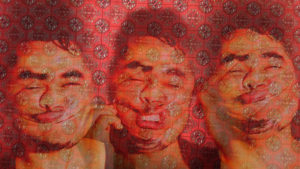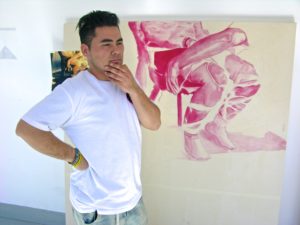Artist celebrates diversity
Former refugee and emerging artist Mehdi Jaghuri has created an art gallery devoted to diversity and inter-cultural harmony.
Mehdi, who fled his homeland Afghanistan in 2005 as a member of the persecuted Hazara minority, is the driving force behind the Connections Gallery in Dandenong.
“We wanted to showcase diverse artists in one space, so we created the gallery,” Mehdi said.
“We now have Greek, Cambodian and Indonesian artists exhibiting as well as Afghans,” he said.
The gallery is a four year project and there are plans for a multicultural art prize.
Mehdi is also presenting his forth solo exhibition titled ‘Remember that Time’, a mixture of painting, sculpture and video works that seek to critically explore an array of social, political and cultural issues.
The exhibition is an accumulation of a year’s work Mehdi produced during 2015, centred on his memories of war and cultural experiences of his birth country – including poverty, society and culture of Afghan people.
Now based in Melbourne, the artist is studying a Bachelor of Fine Arts at Monash University.
Mehdi came to Australia as a 12-year-old refugee in 2005. His father had arrived in 1999 among the first Afghan asylum seekers to come by boat.
He grew up in Hazaraga, in central Afghanistan, the traditional homeland of the ethnic minority Hazara people.
“It was a very difficult and dangerous life as a kid. We had no schools and no education and not much fun. From 6-years-old to 10 you worked as a shepherd and from 12 you worked as a farmer for the rest of your life. It was a very simple life,” Mehdi said.
“We were constantly in fear of attacks by the Taliban and other groups. We had to play close to home as kids in out village. At night we could hear the sound of weapons being fired and a lot of terrible things happened,” he said.
“But my parents were very protective of us and kept us safe.”
Mehdi said his sisters, who were both born in Australia, have had completely different childhood experiences to his.
“They are lucky, they have never experienced fear; they have had so many choices with the education and other things,” he said.
“Australia was a totally different place for us when we first arrived. We had only two hours of electricity in my village so we had no lighting. I had never see TV when I came here.
“We had no bathroom, we showered under a waterfall and washed out clothes in a lake.
“Everything was upside down here in Australia but it was like heaven.
“In my village I had a donkey but here there was public transport – which I had never seen before.
“I had also never seen big buildings –we lived in clay houses. After we arrived at the airport and were travelling into the city I asked about the mountains with the lights on them – but they were tall buildings.
Mehdi said being able to go to school was a “dream” for him.
When Mehdi first arrived in Melbourne, he studied English for time and then went to high school in Year 8. He did his VCE and then a Diploma in Visual Arts at Victoria University.
Mehdi is now in his second year of a bachelor’s degree.
He said he felt grateful and blessed to be given those opportunities.
“One of the most important things is that I want to say thank you to this country. The chance to get an education has been so important to me,” Mehdi said.
“Australia is such a peaceful country where no one can tell you what and what not to do.
“Every day when I wake up I feel safe – it is a relief,” he said.
The Hazara community in Australia steadily over the past fifteen-or-so years to the point where there are now an estimated 80,000 living here.
The first Hazara refugees arrived in the late 1990s as attacks on them in Afghanistan and in the Pakistani city of Quetta, to which many had fled from the Taliban, increased exponentially.
As mostly Shia Muslims, the Hazara are targets for violence by extremist Sunni Muslim groups such as the Taliban and Lashkar-e-Jhangri.
More than 1500 have been killed and 4000 maimed over the past decade in Pakistan and not a single perpetrator has been brought to justice in that time. It is not known how many more have been killed by the Taliban inside Afghanistan.
Hazaras are the third largest ethnic group in Afghanistan, at about 2.8 million, the majority of whom are Shiite Muslims. They also have a population approaching 500,000 in neighbouring Pakistan.
The word Hazar means ‘‘thousand’’ in Persian and some experts believe they are descendants of Mongol soldiers left by Genghis Khan in the 13th Century; a theory supported by the Hazaras’ distinctive Asiatic facial features.
The Hazara comprise the largest ethnic group seeking asylum in Australia and this exodus from terror in Afghanistan and Pakistan has produced a thriving community among at Dandenong, in Melbourne’s south-east.
Laurie Nowell
AMES Australia Senior Journalist












